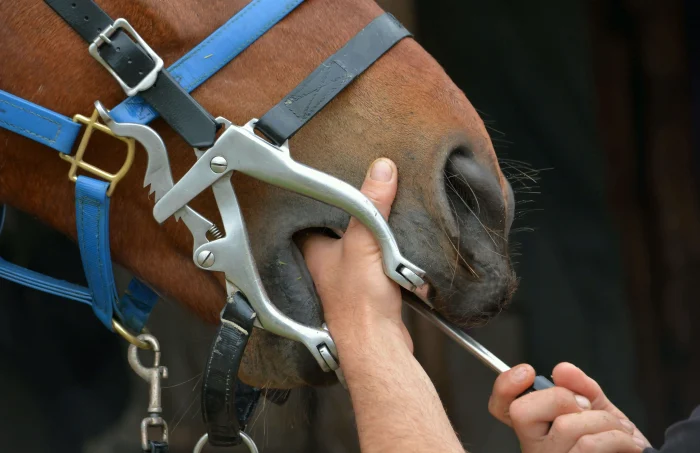Like humans, there is a legal requirement in the UK for all horses and ponies to be registered at birth. Unlike a human baby however, a young horse or pony will be microchipped soon after it is born, with the details registered on a central database for the relevant breed society. Following this, a corresponding equine passport will be issued. Both the microchip and passport will include details of the date of birth.
It is however also possible to estimate the age of a horse by looking at its teeth, a practice known as "aging by dental examination." We spoke to James Arkley, the Chairman of the British Association of Equine Dental Technicians to find out more about how to tell the age of a horse by looking at his teeth.
James said: “Aging by dental examination can have a considerable degree of accuracy in determining the age of young horses. However, the probability of error increases as age advances and it becomes a bit of a guess after the horse reaches 10 to 14 years of age.”
Our horse insurance team were keen to find out more, so James explained further:
Here is a general guide to aging a horse based on its teeth:
Incisors (Front Teeth): A foal will have deciduous (baby) incisors that are temporary until the adult incisor teeth erupt through. By the age of 2 ½ the permanent incisors begin to come through and a horse will have a full set of permanent incisors by age 5.
The pattern in which the baby teeth arrive;
- 1st incisor (or centrals) erupts at birth or within the first week.
- 2nd incisor (or intermediate) at 4 to 6 weeks.
- 3rd incisor (or corners) at 6 to 9 months.
The baby teeth are then replaced by permanent adult teeth, which arrive in this order;
- 1st incisor (or centrals) at 2 ½ years.
- 2nd incisor (or intermediate) at 3 ½ years.
- 3rd incisor (or corners) at 4 ½ years.
- Canine teeth at 4-5 years (more prevalent in male horses).
Canine teeth are generally present in male horses and erupt at around 4-5 years of age. Canine teeth or "tushes" may appear midway between the incisors and molars in the case of geldings or stallions but can appear in mares although it is not common and they tend to be much smaller in size.
Premolars and Molars (Back Teeth): The Deciduous (baby) premolar teeth are either present at birth or within the first 2 weeks for all premolars.
Permanent premolars and molars generally erupt along these timescales and in this order:
- 1st premolar (or wolf tooth) 5-6 months, 2nd premolar 2 ½ years, 3rd premolar 3 years and the 4th premolar 3 1/2 years.
- 1st molar 9-12 months, 2nd molar 2 years, 3rd molar 3 years.

Other aspects to note when aging a horse by his teeth are:
Galvayne's groove. A groove said to appear at the gum margin of the upper corner incisor at about 10 years of age. The Galvayne’s groove extends halfway down the tooth at 15 years and reaches the table margin at 20 years. It then is said to recede and disappear at 30 years.
The angle and shape of the Incisors. As a horse ages, the angle of the incisors changes, becoming more acute. The wear patterns and shape of the incisors can also provide clues about the horse's age. The teeth appear broad and flat on the occlusal surface in young horses. They may be twice as wide (side to side) as they are deep (front to rear). This condition reverses itself in horses that reach or pass 20 years. From about 8 to 12 years the occlusal surfaces become oval, then triangular at about 15 years. Twenty-year-old teeth may be twice as deep from front to rear as they are wide. External influences that make ageing teeth difficult, stabled animals can appear younger than they are, whereas those grazing abrasive soiled areas can appear relatively old because of differential rate of wear on the teeth. Corner hooks appear on the upper 3rd incisors occur due to a change in angle of the incisors and appear around 7 years and 11 years of age.
Changes on occlusal surfaces;
- Dental star: Appears on the lip side of the tooth in front of the mark. 1st incisor at 5 years, 2nd at 6 years, 3rd at 7-8 years. It is not hugely accurate. When it first appears, it is line shaped and parallel with the front of incisor. In older horses it moves to the centre of the tooth and becomes rounder on shape.
- White spot: In the middle of the dental star a white spot appears on the 1st incisor around 7-8 years, 2nd incisor 9-11 years, 3rd incisor 11-13 years
- Dental cups: Disappear on the lower 1st incisors around 6 years, lower 2nd incisors at 7 years, lower 3rd incisors at 8 years, upper 1st incisors at 9 years, upper 2nd incisors at 10 years and upper 3rd incisors at 11 years.
“It is essential to note that individual variations and factors like diet and dental care can impact the condition of a horse's teeth, making it challenging to determine an exact age solely based on teeth. Consulting an equine dental specialist or advanced dental practitioner veterinarian or qualified equine dental technician for a more accurate assessment is recommended.” It is important to have your horse’s teeth checked regularly by a qualified vet or equine dental technician.
About SEIB
SEIB have been arranging insurance for horses for 60 years. This experience allows us to tailor policies to suit your circumstances and ensure that you and your horses are covered should the worst happen.